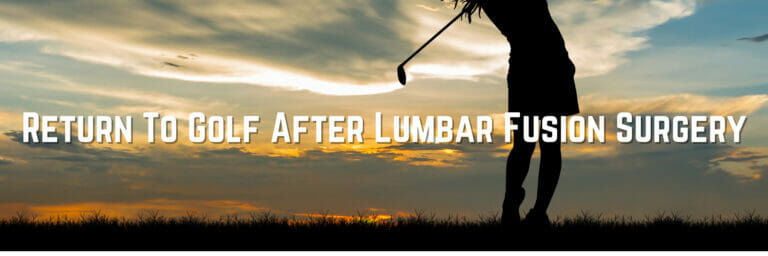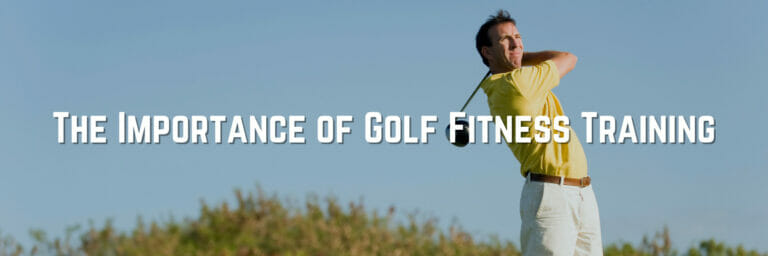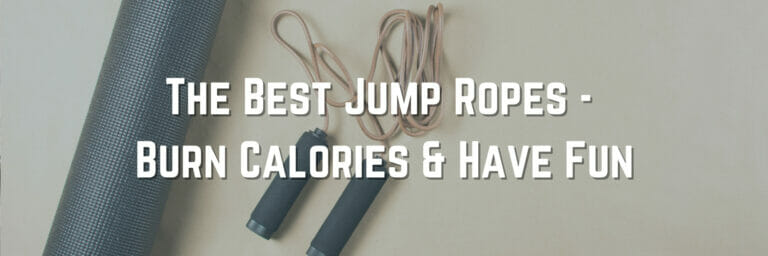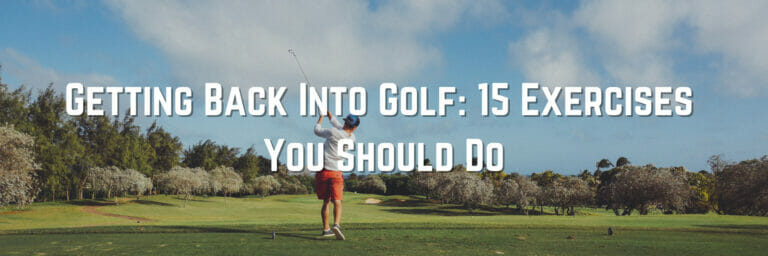Return To Golf After Scoliosis Surgery

!!!!DISCLAIMER!!!! This site may contain Amazon & other affiliate links.
This means if you click on one of the product recommendation links, this site may receive a small commission. This is at no extra cost to you and may include exclusive discounts when possible. This helps support this site and allows us to keep making content like this. Thank you for your support!
Scoliosis can affect a patient in many ways. Aside from the physical symptoms of scoliosis like back pain or a curved spine, scoliosis can also affect the psychological well-being of an individual.
It’s not uncommon for people with scoliosis to become self-conscious about their appearance or be concerned about how other people view them because of their scoliosis.
This can impact a person psychologically and can create feelings of sadness, depression, anger, or anxiety, which may lead to trouble at work or home.
How Scoliosis Can Affect Your Golf Game
Scoliosis causes one’s spine to be curved sideways or backward and affects about 7 million people in the United States alone. Scoliosis can be classified into three categories, including thoracic scoliosis, in which the center of the spine is curved sideways; lumbar scoliosis, where the lower back is curved sideways and kyphosis, which is when a person has an excessively arched upper back.
Scoliosis can affect your golf game in several ways. Scoliosis usually affects a person’s flexibility, so it may become increasingly difficult to have flexible swing mechanics.
Being flexible is an important aspect of having a good golf game because it allows you to use your hips and legs during the swing. If you have scoliosis, it can also make it harder for you to develop a full range of motion when swinging the club.
The reduced range of motion will not only affect your swing mechanics but will also make playing more difficult if your golf club still has the original length after scoliosis surgery. Less movement also makes it hard for a person to get out of bunkers if he/she should happen to find themselves in one.
Scoliosis can cause physical pain as well as mental pain, which is why many patients turn to activities like golf to relieve their symptoms.
Scoliosis Surgery
Treatment for scoliosis may include bracing or surgery, depending on the severity of the curve and the cause. Bracing is a non-surgical treatment that is typically used on scoliosis sufferers who are too young to undergo surgery.
Scoliosis surgery is performed by an orthopedic surgeon to either straighten the spine or put a stop to further curvature. The procedure usually begins with an incision made down the center of the back, from the top of the shoulder blade down to the near the buttock area.
Metal instruments are used to remove soft tissues and muscles from around your spine so that it can be corrected with rods, screws, or other hardware.
Scoliosis Surgery Recovery

Scoliosis surgery recovery usually takes a few months and may require you to stay in the hospital for one or more nights. The normal recovery time depends on several factors, including your personal health, your age, and the extent of scoliosis. An average recovery time for scoliosis surgery is 4-8 weeks.
According to a journal published in the US National Library of Medicine National Institutes of Health
“The individuals with scoliosis have been reported to be able to participate in equally strenuous physical activities regardless of the spinal fusion.
A comprehensive physical activity plan for individuals with scoliosis should incorporate three components: aerobic activity, muscle strengthening, and building bone mass.”
If you’ve recently undergone scoliosis surgery, it doesn’t mean that you have to give up enjoying your favorite hobby. Golf can actually help speed up the healing process and help strengthen bones, muscles, and joints affected by scoliosis surgery.
Physical activity like golf also helps relieve stress caused by the disease or pain caused by your treatment. Golfing is a great way to help improve your overall health, both physically and mentally.
Getting Back into Your Exercise Routine
Now that you’ve been scoliosis surgery and are on the road to recovery, it’s time to get back into shape. This section will look at how to take steps toward improving your life by making a healthy lifestyle change, but here’s an article on physical therapy for best golf performance.
It should also help you get out of bed and start moving around better without having to worry about pain or other side effects. So, let’s get started.
Types Of Exercise
According to WebMD, by doing exercises targeted for scoliosis, you can increase your core strength, improve your posture, and strengthen the muscles in your lower back. This will help correct your spine’s positioning and mitigate some of the discomforts of living with scoliosis.
These exercise includes walking and may also include water aerobics, weight training, yoga, tai chi, and a variety of other exercises. Thirty minutes of exercise per day most days of the week is recommended for those who are trying to stay fit.

Get Moving!
There are many activities that are easy to do that will help you get moving without over-exerting yourself. Some activities to try to include walking, jogging, or running outdoors if the weather permits.
You can also try swimming or bike riding. Get creative and try activities like golfing, tennis, swimming, or even gardening. You can also go ice skating if you’re not used to being on your feet that much.
If you’re new to exercise, it’s important to listen to your body and only push yourself so far, especially at first. If you feel pain or discomfort while exercising, do not continue for more than five minutes before taking a break for one minute.
This will help maximize your time spent exercising and prevent injury and the pain in your back or neck that has likely plagued you for some time now.
If you are looking for a quick scoliosis exercise to do at home, watch this video:
Non Surgical Treatments for Scoliosis Pain and Aches
Scoliosis pain and aches are not limited to just the spine, but they also include the shoulders, hips, and ribs. These areas of your body are affected by scoliosis pain and aches because they seem to be out of place when you stand straight. It’s true, though, that these areas should be out of place when you stand straight.
Think about how much your feet have spread as you’ve grown over the years. This is a good example of why all areas of your body should be out of place when standing straight.
The shoulder pain and aching are usually caused by muscles in this area pulling on tendons or ligaments that become too long because the bones have grown at irregular rates. Hip pain or aching is caused by muscle spasms in the legs and buttocks that cause your hips and ribs to jut forward.
Rounding of the shoulders can be caused by muscle spasms, pulling on the ligaments that hold the shoulder bones in place.
Scoliosis pain can sometimes be effectively managed with various non-surgical treatments. Unfortunately, these treatments do not work for all types of scoliosis pain because it affects different people differently.
You should always consult your doctor before assuming that these treatments will help you with your scoliosis pain or aches.
Wearing good golf shoes that are designed for your specific foot type will prevent pain or bad posture and may help you achieve a better swing motion.
You may also want to consult a physical therapist before you get started. A physical therapist can help create a new golf swing motion that is safe for you because of your scoliosis and can even give you tips on what shoes or equipment to use.
A physical therapist can also give you advice on how to strengthen the supporting muscles in your back.
Golf After Scoliosis Surgery
Playing golf after scoliosis surgery isn’t really all that different from playing golf before surgery, except that there are some precautions that should be taken into consideration during the recovery process.
It’s important when getting started again after scoliosis surgery or any type of surgery not to overdo it and take it easy until your body is fully recovered.
Many patients feel that you can beat scoliosis pain with the simple act of playing golf. With physical activity, the body feels better because it is being utilized in a healthy way. There are also chemicals produced by your body, like endorphins, during physical activities which will make you feel better.
As a result of these feelings of well-being, you will have a happier outlook on life and greater levels of optimism. This optimism will help reduce some of the negative symptoms caused by scoliosis as well as boost your morale when things don’t always go your way.
The only real downside to playing golf after scoliosis surgery is that the swing motion may be a bit different because your body isn’t as flexible as it used to be before the surgery.
But if you use this time to work on flexibility and get used to having a shorter backswing, then you should do just fine. In fact, this may even make your game better because you’ll have more control over your swing and, therefore, more control over the location of impact with the ball.
Frequently Asked Questions
1. Will scoliosis surgery spoil my golf swing?
The only thing that scoliosis surgery does to your golf game is lengthened the backswing. If you can overcome this physical barrier and still maintain great form, you’ll do just fine.
Many patients have reported that they don’t feel any pain or discomfort after an adjustment period, which means you will be able to work on flexibility exercises and slowly come back to a regular routine.
2. What precautions should I take before playing golf after scoliosis surgery?
It’s very important not to overdo it because your body may not be in top form yet. It’s best to start taking it easy until you feel better and then work your way up.
Don’t push yourself too hard, and if you feel any pain, no matter how slight, stop doing whatever activity caused the pain. It’s also important to check with your doctor before making any changes to your workout routine.
3. Is there anything I can do about the fact that my backswing is longer?
You’ll have to adjust by changing your technique a bit, but most people find that if their form isn’t out of shape, they can still succeed.
4. Will playing golf after scoliosis surgery cause any additional pain?
The only pain you may experience is from overexertion after surgery. This will only last for a short time, however, so don’t worry about it.





